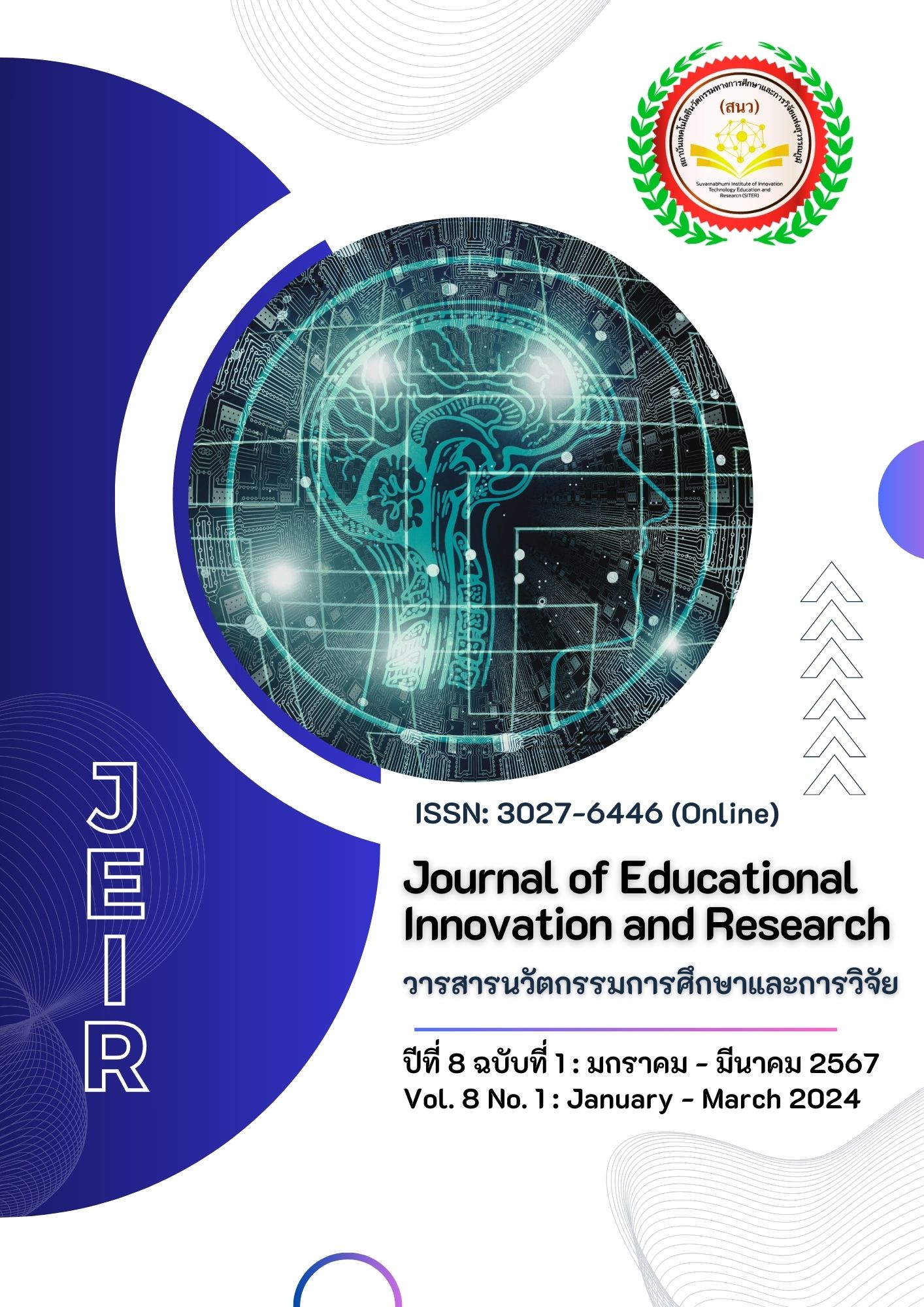การศึกษาความสามารถในการคิดอย่างมีวิจารณญาณทางคณิตศาสตร์ เรื่อง ระบบสมการเชิงเส้นสองตัวแปร ของนักเรียนชั้นมัธยมศึกษาปีที่ 3 ด้วยการจัดการเรียนรู้โดยใช้การสร้างแบบจำลองทางคณิตศาสตร์
Main Article Content
บทคัดย่อ
การวิจัยในครั้งนี้มีวัตถุประสงค์ 1) เพื่อศึกษาแนวทางการจัดการเรียนรู้โดยใช้การสร้างแบบจำลองทางคณิตศาสตร์ที่พัฒนาความสามารถในการคิดอย่างมีวิจารณญาณทางคณิตศาสตร์ และ
2) ความสามารถในการคิดอย่างมีวิจารณญาณทางคณิตศาสตร์ เรื่อง ระบบสมการเชิงเส้นสองตัวแปร ของนักเรียนชั้นมัธยมศึกษาปีที่ 3 ด้วยการจัดการเรียนรู้โดยใช้การสร้างแบบจำลองทางคณิตศาสตร์ก่อนเรียนและหลังเรียน กลุ่มตัวอย่าง คือ นักเรียนชั้นมัธยมศึกษาปี 3 ภาคเรียนที่ 2 ปีการศึกษา 2564 จำนวน 39 คน ซึ่งได้จากการสุ่มแบบกลุ่ม เครื่องมือที่ใช้ในการวิจัย คือ แผนการจัดการเรียนรู้ แบบฝึกหัด
และแบบทดสอบวัดความสามารถในการคิดอย่างมีวิจารณญาณทางคณิตศาสตร์ วิเคราะห์ข้อมูลโดยใช้ค่าความถี่ ร้อยละ ค่าเฉลี่ย ส่วนเบี่ยงเบนมาตรฐาน ทดสอบค่าที และการวิเคราะห์เชิงเนื้อหา
ผลการวิจัยพบว่า 1) แนวทางการจัดการเรียนรู้โดยใช้การสร้างแบบจำลองทางคณิตศาสตร์ที่พัฒนาความสามารถในการคิดอย่างมีวิจารณญาณทางคณิตศาสตร์ ครูควรใช้สถานการณ์ปัญหาที่เชื่อมโยงกับชีวิตจริงของนักเรียนที่มีความซับซ้อน หลากหลายบริบท และควรเตรียมความพร้อมของนักเรียนในด้านเนื้อหาความรู้ที่จำเป็นต้องใช้ในการแก้สถานการณ์ปัญหา รวมทั้งควรใช้คำถามเพื่อกระตุ้นให้นักเรียนคิดและเกิดการเรียนรู้ในแต่ละขั้นตอน ควรเปิดโอกาสให้นักเรียนมีส่วนร่วมในการอภิปราย แลกเปลี่ยนความคิดเห็นร่วมกัน ซึ่งจะส่งผลให้นักเรียนใช้ความสามารถในการคิดอย่างมีวิจารณญาณทางคณิตศาสตร์ในการแก้ปัญหาและตัดสินใจในสถานการณ์ปัญหาที่ซับซ้อนได้อย่างมีประสิทธิภาพ และ
2) ผลของความสามารถในการคิดอย่างมีวิจารณญาณทางคณิตศาสตร์ของนักเรียนที่ได้รับการจัดการเรียนรู้โดยใช้การสร้างแบบจำลองทางคณิตศาสตร์หลังเรียนสูงกว่าก่อนเรียนอย่างมีนัยสำคัญทางสถิติที่ระดับ .05
Article Details

อนุญาตภายใต้เงื่อนไข Creative Commons Attribution-NonCommercial-NoDerivatives 4.0 International License.
เอกสารอ้างอิง
Amalia, Q., Hartono, Y., & Indaryanti, I. (2019). Students’ critical thinking skills in modeling based learning. Journal of Physics Conference Series, 1166, 1-6.
Amornchewin, B. (2013). Critical Thinking: Principles for the development of logical thinking and judgment. Bangkok: Prints.
Chatcoop, S., & Chuchart, U. (2001). Critical thinking. Bangkok: Thai Watana Panich.
Cheausuwantavee, C. (2012). The development of mathematics instructional model to enhance higher order thinking and habits of mind of secondary school students [Doctoral Dissertation, Silpakorn University].
Eric, C. (2009). Mathematical modelling as problem solving for children in the Singapore mathematics classrooms. Journal of Science and Mathematics Education in Southeast Asia, 32(1), 36-61.
Ketthong, T. (2008). Effects of organizing learning activities by using mathematical modeling process on problem solving ability and reasoning in mathematics of ninth grade students in schools under the office of the basic education commission in Lopburi [Master’s Thesis, Chulalongkorn University].
Kwangsawad, T. (2018). Teaching Critical Thinking. Ratchaphruek Journal, 16(3), 1-9.
Makanong, A. (2011). Mathematical process skills: Developing for development (2nd ed.). Bangkok: Faculty of Education, Chulalongkorn University.
Makmeesub, D. (2010). A study of critical thinking effects and learning achievement with blended learning by problem solving process in selection and utilization of instructional media subject of undergraduate students [Master’s Thesis, Silpakorn University].
Marasri, S. (2019). Developing Critical Thinking Skills in the 21st Century. Journal of MCU Nan Review, 3(2), 106-122.
Nenthien, S. (2017). Mathematics learning with Real-World problems based on mathematical modeling. Journal of Education Studies, 45(2), 238-253.
Office of the Basic Education Commission (OBEC), (2017). Indicators and learning standards of mathematics learning area (revised in B.E. 2560) in accordance with the basic education core curriculum B.E. 2551. Bangkok: Press of the agricultural co-operative federation of Thailand.
Santos, M., Belecina, R., & Diaz, R. (2015). Mathematical Modeling: Effects on Problem Solving Performance and Math Anxiety of Students. International Letters of Social and Humanistic Sciences, 65, 103-115.
Schafersman, S. (1991). An Introduction to Critical Thinking. Retrieved April 15, 2021, from https://facultycenter.ischool.syr.edu/wp-content/uploads/2012/02/Critical-Thinking.pdf
Tunta, N. (2020). Action Research for The Development of Learning Implementation Using Mathematical Models to Enhance Mathematical Problem Solving Skills on The Topic of Function for Grade 11 Students [Master’s Thesis, Naresuan University].
Upper Secondary Education Bureau. (2017). 21st Century Skills. Retrieved April 15, 2021, from https://webs.rmutl.ac.th/assets/upload/files/2016/09/20160908101755_51855.pdf
Wangsila, P., Supap, W., & Klineam, C. (2018). The study of using mathematical modelling to enhance mathematical creative thinking in geometric analysis topic for 10th grade students. Journal of Education Naresuan University, 22(3), 150-163.


